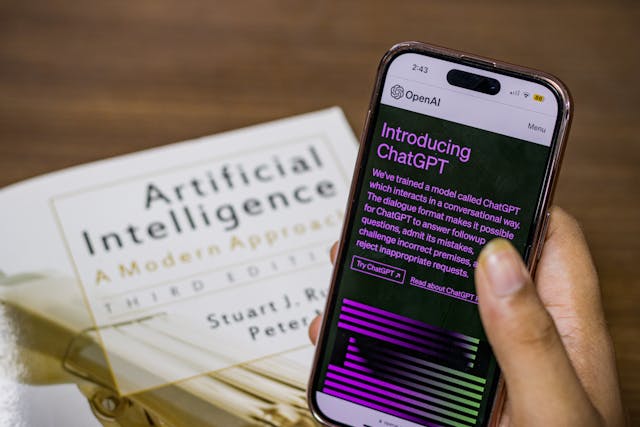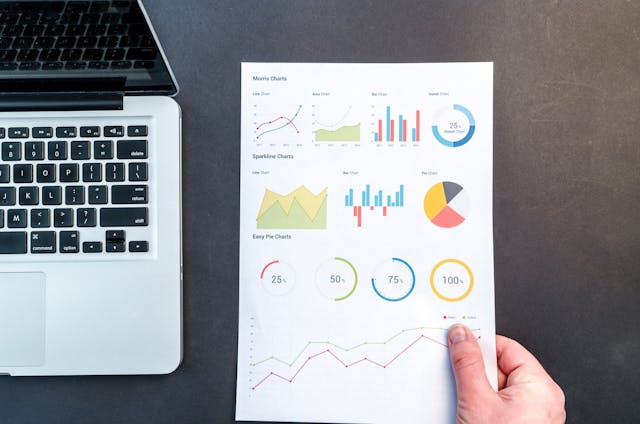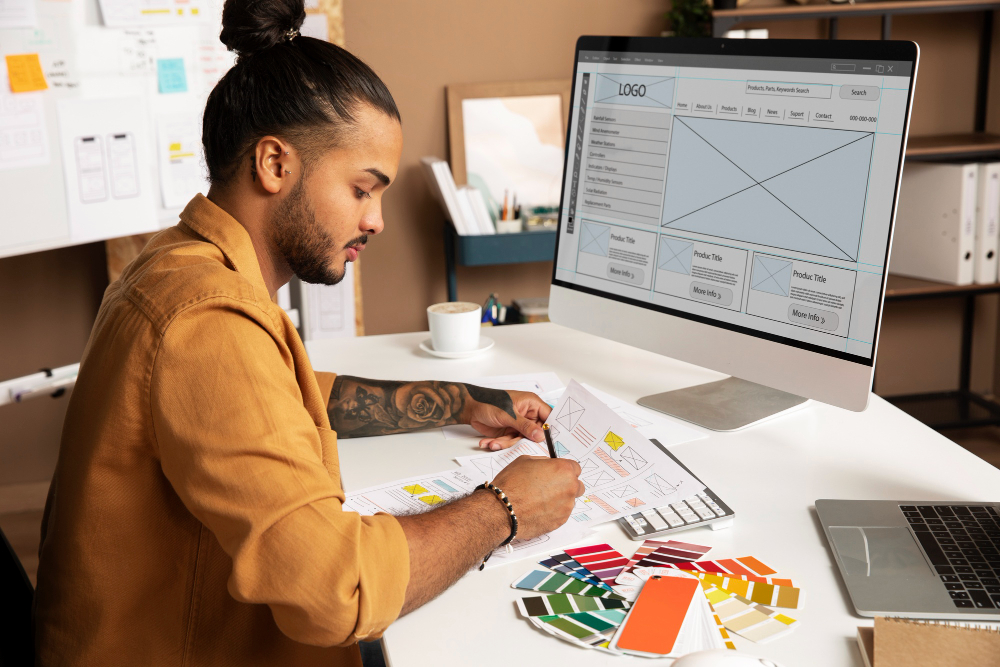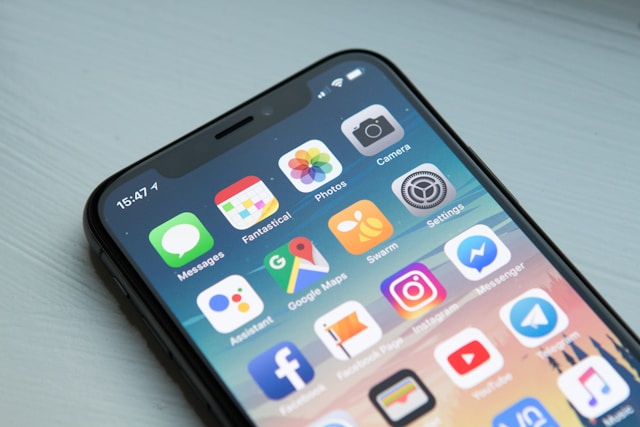Artificial Intelligence (AI) has paved the way for exciting advancements across the entirety of the digital landscape. Specifically, however, AI considerably benefits a particular corner of the digital landscape—UX design.
Many UX professionals implement AI in UX design to automate or enhance particular aspects of the UX design process. As a result, by using AI in UX design, UX designers can allocate less time to completing repetitive tasks. This being the case, they can dedicate more time to optimizing their designs in order to make them more user-centric. User journey mapping helps visualize the entire experience of a user interacting with a product, from initial contact to final outcome.
Due to the prevalent reliance on AI for UX design, its considerable usefulness has become worrying for many UX designers. Expressly, these worries pertain to the idea that AI has made the role of human designers redundant.
In today’s guide, we’ll explore the actual impact of using artificial intelligence in UX design. In addition, we’ll address how UX designers employ AI throughout the design process and reveal handy AI-driven design tools. By the time you’ve finished reading this guide, you’ll fully understand the dynamic between AI and UX design.
What Is AI?
Before you can explore the relationship between AI and UX design, you must first understand what AI actually is.
AI, or artificial intelligence, is a technology that enables machines and computers to emulate human intelligence and problem-solving competencies. AI can perform tasks we typically associate with cognitive functions, such as interpreting speech, identifying patterns, and analyzing data.
Artificial intelligence works by combining large quantities of data with intelligent, iterative processing algorithms. So, although many consider AI a system in itself, it’s actually a series of technologies within a technological system.
One algorithm that people often confuse AI with is machine learning (ML).
Machine learning refers to a branch of AI that automatically allows a system to learn and continuously improve from experience. Much like UX researchers, machine learning analyzes data, generates insights from its findings, and makes informed decisions from those insights.
The more data a machine learning algorithm has, the better the model will perform.
So, with the nature of AI in mind, let’s explore the impacts of AI in design.

The Impact of AI on UX Design: The Future of UX Design
As previously mentioned, AI can prove a powerful tool and simultaneously a great worry for UX designers.
As a powerful tool, AI can open doors to new, exciting opportunities for UX designers. AI streamlines crucial parts of a UX designer’s role, like extracting relevant information from copious volumes of data.
However, aside from automating vital tasks, AI can help designers create a more personalized user experience. From catalyzing wireframe development by analyzing design specifications and user inputs to ideating user interview questions, AI enhances user-centric design.
Ultimately, for both UX designers and real users, AI can help create hyper-personalized, sophisticated digital products.
So, what does this mean for the future of UX designers? It means that, despite AI’s clear advantages, it doesn’t pose a threat to a UX designer’s job for one reason. All of the currently existing algorithms can’t empathize with the real human experiences and emotions that shape our digital products.
A common pattern among successful digital products is the implementation of human-driven, personal touches that influence the users’ emotions. Therefore, it’s safe to assume that the role of UX designers won’t go away anytime soon.

How To Use AI in UX Design: Improving Your Designs
Now that you know AI won’t replace UX designers, it’s time to see how the two can effectively work together.
Expectedly, AI provides a wide range of solutions to mundane, repetitive tasks and even just regular mind-blanks. That being the case, it’s handy to know how you can use AI for design.
To help you grasp the limitless possibilities that AI can offer UX designers, we’ve revealed how to use AI in UX design below.
1. Analyzing User Data
With AI, UX designers no longer have to spend hours manually sifting through the data from user research. Alternatively, with AI at their disposal, designers can automate such data collection processes and analyze them to find valuable patterns. UX competitive analysis involves evaluating and comparing the user experience of similar products or services to identify strengths, weaknesses, and opportunities for improvement. In addition, A UX specialist carefully designs interfaces to ensure a seamless and enjoyable user experience.
As you can imagine, using AI in this way makes it easier to decipher the reasoning behind qualitative trends. What’s more, you can predict future user behaviors and quickly validate hypotheses. In turn, this leads UX designers to create digital products that flaunt optimized usability. Remember that staying updated with design trends can help ensure your website looks modern and appealing to users.
Additionally, by streamlining the UX research process, UX researchers have the time to empathize and learn more about their users.

2. Creating User Personas
On the topic of user data, AI tools can also create accurate, contextualized user personas based on user research data.
What’s more, when AI tools analyze vast amounts of data, they can identify complexities that humans may otherwise not notice. As a result, you can create user-centric products that target your audience more effectively.
Additionally, there are even some AI tools that can conduct sentiment analysis on social media platforms! Simply, sentiment analysis refers to the categorization of opinions and attitudes expressed in a piece of text. Thus, with the right AI tool, you can turn users’ discussions on social media into valuable insights for user personas.
3. Optimizing UX Writing
An identifiable quality of effective digital products is the seamless connection between design and content. In other words, you shouldn’t disregard the significance of high-quality, helpful UX writing.
From CTAs to error messages, every word you use in your product copy should exhibit clarity, conciseness, and personality. If your product’s copy showcases these qualities, it will actively smoothen and thus enhance the user’s navigational experience.
AI tools can help you with your mission to create an exceptional product copy. Due to AI’s capabilities regarding user behavior analysis, AI tools can also suggest word choices based on user behavior data. The suggestions provided will align with your users’ preferences and improve their navigation through your product. Plus, it will make their overall experience much more enjoyable.
Equally important, AI will also ensure that your copy meets SEO requirements so that your product will reach more users!
4. Enhancing Prototyping and User Testing
A crucial stage of the design process is, of course, the prototyping stage. Going hand in hand with prototyping, user testing sessions are equally crucial to the UX design process. Aside from an AI tool’s basic functionalities, such as helping you recruit suitable participants, artificial intelligence can offer additional benefits.
When UX designers reach the prototyping stage of the design process, AI tools can provide advanced user interaction simulations.
With a clearer picture of how users interact with your product, you can sometimes even make monumental refinements. Consequently, you have a better chance of generating success for your brand post-launch.
What’s more, you know you have the time to make those improvements. AI tools will automate time-consuming processes like gathering user feedback so you have more time to work on your prototypes.

5. Increasing Accessibility
Ensuring your product is accessible for all user types is more than just morally right; it’s a legal requirement. Given the importance of accessibility, UX designers must stay up to date with accessibility standards.
By using proficient AI tools, you can make sure you and your brand remain compliant with WCAG 2.2 guidelines. From voice recognition to color adjustments, AI will help you ensure all user types can access and enjoy your products.
6. Automating Design Workflows
Within the world of UX design, it’s not uncommon for workflows to become incredibly demanding.
With the right AI tool by your side, you can streamline said design workflows.
The automation that AI allows for can help you create recurring design features. Furthermore, artificial intelligence excels when it comes to recognizing patterns. As a result, AI can help you assemble design elements as they simultaneously adapt to new environments.
As a UX designer, you’ll reap the benefits of more efficient ideation practices. Overall, with AI, your workflows will become considerably less laborious.
7. Diminishing Design Biases
It’s essential that, when you come up with user-centric design solutions, you suspend your own biases. If you don’t, it will significantly – and negatively – impact your finalized product.
Typically, design bias occurs during the UX research process and, specifically, during user surveys. When UX researchers utilize biased survey questions, it’s harder to determine which preferences belong to the user and the researcher. Therefore, you end up creating a product that your target users don’t need.
Beyond that, you risk excluding some of your target audience with design bias.
AI can combat design bias because it can identify patterns of exclusivity in your users’ interactions.
8. Improving UI Design
The quality of a user’s experience doesn’t just solely rely on the quality of the research or design behind it. It also relies on the quality of the UI design.
UI designers focus on optimizing both static and interactive elements such as animations, color schemes, images, and icons. In other words, they bring a UX designer’s vision to life by blending their product’s functionality with meaningful aesthetic value.
AI tools that flaunt UI design-related functionalities help UI designers create meaningful aesthetic value. With AI, UI designers can create a visual design that enhances the user’s experience while adhering to their brand’s personality. From large libraries of design elements to brand-oriented typography, artificial intelligence offers substantial advantages for UI designers.

AI For Designers: Tools You Should Use
So, now you know why and how AI is consistently revolutionizing the UX design process. By now, it’s likely that you’re incredibly eager to start experimenting with AI tools for yourself.
To help you find your new go-to AI tools, we’ve assembled a list of the best AI for designers.
The Best AI Tools for Analyzing Large Volumes of User Data
Below, we’ve listed a few of the best AI tools that will help you analyze copious amounts of research data. These tools will enable you to find patterns within your data that will help you create user-centric products.
- Research AI
- Hotjar AI
- Tableau
The Best AI Tools for Creating User Personas
User personas help you identify your target audience and understand their motivations and desires. The following AI tools will help you create accurate, contextualized user personas.
- Enlighten AI
- Smartone
- Pulsar Platform
The Best AI Tools for UX Writing
A UX writer’s job is to create meaningful, engaging textual content within a digital product. Given the importance of engaging your users, we’ve listed some AI-driven tools that will help you produce excellent copy.
- Frontitude
- Copy.ai
- Unbounce Smart Copy
The Best AI Tools for Prototyping and User Testing
Prototyping and user testing are essential steps when finalizing a digital product that will appeal to your target audience. For that reason, we recommend using the AI-powered tools we’ve listed below.
- Uizard
- Fronty
- Framer
The Best AI Tools for Accessibility
Designing with accessibility means ensuring all users can access, understand, and enjoy the products you create. If you’re uncertain as to whether your products meet the essential accessibility requirements, use the following tools.
- AccessiBe
- UserWay
- Khroma
The Best AI Tools for Design Workflows
Streamlining design workflows will allow you to dedicate more of your time to user-centricity. Consider using the tools we’ve listed below to help you automate your workflows.
- Brainpool AI
- LucidLink
- Decisions
The Best AI Tools for Design Biases
User-centricity and a designer’s personal biases simply do not mix. Use the following tools to ensure you haven’t incorporated your own biases into your designs.
- MonkeyLearn
- Acrolinx
- Google Fairness Indicator
The Best AI Tools for UI Design
UI design focuses on creating functional, visually appealing user interfaces that enhance the user’s experience with a product. The three AI-led tools below will help you optimize the static and interactive visual elements within your products.
- Fontjoy
- Colormind
- Adobe Sensei
AI in UX Design: Modernizing The Design Process
The key takeaway is that UX design will always serve as a reflection of an understanding of the users’ needs. Concerning AI, artificial intelligence can help you and other designers optimize and – most importantly – revolutionize the user’s experience.
So, with this in mind, you should experiment with AI-generated tools in a way that positively shapes your design process. Be mindful to approach AI with clarity and conciseness, as well as adhere to data privacy laws. Lastly, have fun with AI and always remember to prioritize the one thing AI can’t automate – user empathy.
To help you get started, we have the perfect source of inspiration for consistently innovative design solutions. Meet Page Flows.
Page Flows is the home of nearly 5,000 user flow recordings, working alongside revered brands like Disney and Google. With Page Flows, you’ll access all of our recordings pertaining to vital flows, including user onboarding and upgrading.
Our dedication to user-centricity has made it so that over 1,000 happy customers always have reliable design inspiration. What’s more, our customers know precisely how to interact with their users with Page Flows. How? We collect emails when we record user flows!
We share a similarity with AI in UX design – we also strive for hyper-personalized user experiences that exceed the users’ expectations!
Why wait for the right inspiration to find you? Get started today and access a wealth of user flow recordings, screenshots, and emails. With us, you can learn how to refine your professional practice as a UX designer and create exceptional user experiences!





